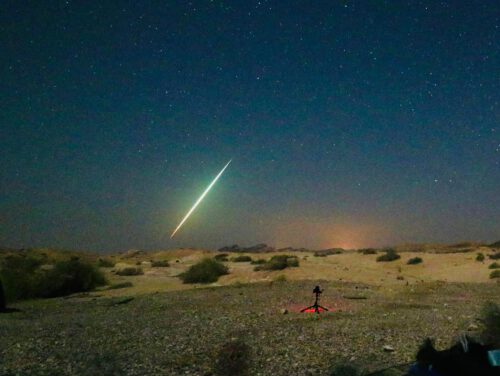Yesterday, the record for August's meteorite shower was recorded - the Perseid shower. One of them, a particularly huge fireball, was caught on camera by the chairman of the Israel Astronomical Society, Nadav Rotenberg

It's August again, and that means the big meteor shower is coming down - the Perseid shower. Yesterday, on 12/8/20, there was a record high of rain and there were complaints about congestion on Route 40 southbound to such an extent that people had to pull over and watch from near the road, with the lights of the cars getting in the way.
A meteor shower occurs when the Earth passes through a stream of ice fragments, dust and small rocks left after a comet passed through the area. When this current intersects with the Earth's orbit, the meteor is created. We see the trail left behind by the burning of these fragments - from the size of dust to the size of a pea, in the upper atmosphere.
The Perseid meteor was created by the periodic comet Swift-Tuttle which took 133 years to orbit the year. Swift-Tuttles will approach the Sun again in 2126. To an observer on Earth it appears as if they are coming from a fixed point in the sky. Of course, this is an illusion that produces an effect similar to that seen in the Star Trek series, only in reverse. The Perseids appear to come from around the star Eta Persei in the Perseus group, named after a hero from Greek mythology, and hence the meter's name. However, the name is no longer so accurate because the radiant of the meter (the reflection of the place in the sky from which it comes) moves a little towards the nearby constellation - Cassiopeia.
Those who still want to watch the remnants of the meter in the coming days should take into account that the moon rises around one in the morning local time, but there is no need to despair. The moon is at a low height in the sky, and is about 42 degrees from the meter. It is enough to hide from the moon behind a hill or a building (without lights).
In the attached photo taken by Nadav Rotenberg, the chairman of the Israeli Astronomical Society, in the Ramon Crater area yesterday (12/8) you can see a ball of fire or as it is called a bolid.
A bolide is an extremely bright meteor, reaching at least the brightness of planets like Jupiter or Venus. Every night you can see several of them crossing the atmosphere. However, their number is increasing when the Earth passes through a stream of debris left behind by a comet, as happens in the well-known meteor showers, including the Perseid shower in August. And this time he was also caught on camera.
The Facebook page of the Israeli Astronomical Society
More of the topic in Hayadan:

One response
The moon sets at one, not rises at one.